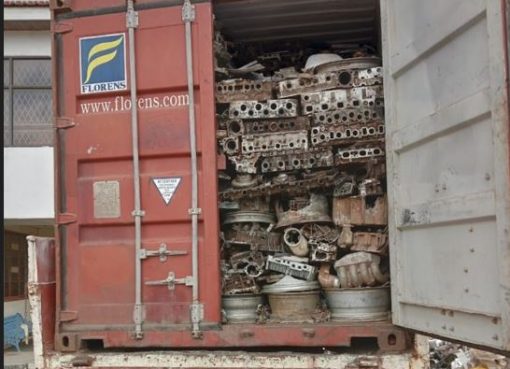While many still hold the belief that Sorghum is a poor man’s crop, over 6000 farmers in Siaya County have a completely different perspective of the crop.
To them, a campaign dubbed “Jilishe kisha uuze” (Grow, feed and sell) championed by East Africa Breweries Limited and other agricultural stakeholders gels well with one of the government’s Big Four Agenda – Food security – and has made the crop that is classified by the ministry of agriculture among the orphaned crops, a crucial source of money in their pockets and a great contributor to food security and nutritional well-being of their families.

At the end of the first season of the campaign towards the end of 2018, more than 6,800 small scale farmers from across the county had earned over Sh. 390 million from the 12,642 metric tons of the produce sold to the beer making giant, says a report by the county director of agriculture, Isaac Munyendo.
Munyendo says that the farmers, who had over 10,539 acres under the crop, supplied the sorghum through aggregators and registered farmer groups contracted by the EABL.
According to one of the farmers who planted the crop and later sold the harvest to EABL, George Spencer Wambiya, the white sorghum is a blessing in disguise for Siaya farmers.
“I was able to sell my harvest and retained a 90 kilogram bag for consumption,” says the 37 year old farmer from Karindi village in Kabura /Uhuyi sub location, South West Alego location.
He says that the sorghum, when ground into flour, makes very good porridge and its ugali is heavier and tastes better, unlike the traditional sorghum that many people in the county prefer.
Wambiya said he harvested 13 bags of 90 kilograms each of the Gadam variety from his two acre farm and sold a kilogram at Sh 32 to an aggregator.
The farmer, who ventured into farming four years ago, however says that the venture has several challenges, key among them, the birds menace.

“Having spent about Sh. 20,000 on the venture, I made close to Sh. 15,000 profit within two and a half months that the crop takes to mature” he says adding that he would have harvested more had it not been for the birds which attacked his crop.
He says that birds start attacking the crop within the second month and a farmer must spend a lot of time in the farm chasing them away.
The farmer laments that when EABL agents were going round encouraging farmers to take up the crop, they were promised that a chemical to deter the birds from causing damage to the crops will be availed but this did not come.
He says that the birds menace made him lose massively and if a way could be found to minimise the attacks, then farmers would reap big from the venture.
Another challenge that the farmer noted in his new found cash crop was lack of inputs such as seeds and fertiliser.
“The seeds were availed late, same as subsidised fertiliser which were not enough and we had to buy the expensive inputs from local agro-vet shops,” he says.
An aggregator who coordinates the purchase of white sorghum in Siaya, Linet Akoth Otieno describes the “Jilishe Kisha Uuze” initiative by EABL as a good venture with a lot of potential in future.
Speaking to Kenya News Agency during a farmers meeting at the Siaya Agricultural Training centre, Linet said the market for white sorghum was big and can absorb more and urged Siaya farmers to take advantage of this.
“Besides cash, it is good for food security,” she says adding that the farmers will end up with money in the pocket which will enable them take care of family needs such as the cost of education and health care.
“Perhaps the best thing, apart from ensuring money in the pockets, is that our raw material is used to make legal and safe drink to cushion our people from illegal liquor that is taking a toll on our youth,” she added.
Linet, who, through her company, Lyeve Enterprises Ltd. Siaya handled 1,500 farmers with approximately 500 acres, said she paid the farmers Sh. 6,400,000 for the 200 metric tonnes delivered during the first season in August, 2018.
She said that her company was paying farmers Sh 32 per kilogram delivered and it was cash on delivery.
Another aggregator, Farm to Market Alliance that is a subsidiary of the Cereal Growers Association handled about 300 farmers from various parts of the county and managed 97.5 tonnes, says its coordinator, Brian Etemesi Sande.
Sande says that Rarieda and Bondo were the leading sub counties in white sorghum production, followed by Ugenya, Alego /Usonga, Gem and Ugunja respectively.
He says that the crop, if planted and taken care of well, will have a big positive impact on the local economy.
“We are buying at Sh. 32 per kilogram while maize at this time is sold at even Sh 20 per gorogoro (two kilogram tin) at harvest time,” he says and challenges the locals to embrace the crop.
Sande however advises the farmers to ensure that they plant only four varieties of the white sorghum, that is; Sila, Gadam, KARI Mtama1 and Advanta as these are the only ones that EABL buys.
He says that unlike in the first season when farmers were supplied with seeds, the coming season will see those interested in the venture buy seeds from the approved stockists.
“In 2018, EABL gave seeds but just about 20 per cent were planted while the rest is probably still in the hands of individuals,” he told a farmers meeting attended by other stakeholders at the ATC.
On challenges, both Sande and Linet are in agreement that threshing of the crop was a big challenge to the farmers during the first season.
“The farmers brought produce full of dust and some even had weevils, an indication of poor post-harvest handling,” said Linet.
The aggregators also complained of transportation challenges, adding that poor access roads made them incur a lot of expenses as they had to go for the crop right in the farms.
Siaya county executive committee member for agriculture, Charles Ogada hails the venture as a good enterprise which offers a ready market to small scale producers. “Their price at farm gate if fair,” says the county minister for agriculture.
He however calls on the small scale farmers to come together in groups and take advantage of economies of scale if they are to reap big in the venture.
“Our farmers can benefit more if they consolidate their activities as they will be able to access inputs and even labour at fair cost hence maximising on their profit,” says Ogada adding that if they stick to the current way of doing things where each farmer is on his or her own, they may not reap enough.
For years, Barley was EABL’s raw material of choice but in 2009, the company decided to include Sorghum in its brewing process hence the heightened campaign to have local farmers go back to the crop that many had despised over the years.
In a bid to ensure success of the venture, the company, through the department of agriculture helped develop a value chain that helps promote the crop, with farmers receiving continuous training on best practices and post-harvest handling.
Kenyan farmers now have a ready market and opportunity to make good returns from sorghum farming.
Siaya County’s climate is among the most conducive for sorghum and millet production and its proximity to the Sh. 15 billion refurbished EABL plant in Kisumu means local farmers are poised to benefit more.
By Philip Onyango





